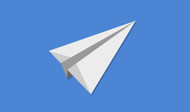How paper planes helped manned flights take-off
By on Dec 7th 2016
Next time you see a commercial jet soaring overhead, take a look and appreciate just how spectacular the science behind the machine actually is.
It seems impossible; how could so much weight move so smoothly through the air? How does it maintain flight? Many pilots and aerospace engineers would be quick to pass on a list of equations and diagrams indicating
just how an aircraft is capable of maintaining flight, but the average passenger flying to Disney World finds it a bit more perplexing.
For centuries, the idea of flight was something many people obsessed over. Whether it was the great Leonardo DaVinci or the genius scientific minds of the ancient Chinese, human flight became something worth aspiring to. The most
basic way to gain some sort of understanding of flight was simply through modeling-before there was ever an airplanes made of aluminum, there were airplanes made of plant matter. These, of course, are paper airplanes.
Paper airplanes likely came into history as a descendent of the ancient flying kite created in China. It appears that the traditionally Japanese art of origami was actually started in China, and it is speculated that paper airplanes were among the first creations of the art. It is likely that while some miniature semi-permanent flying machines
were being crafted so many years ago, it is said that Leonardo Da Vinci was the first to recognize that "air offered resistance to motion-it wasn't until 100 years later that Galileo claimed that velocity and air resistance are relative and proportional." Allegedly, Da Vinci considered building a model plane out of parchment.
However, it was many years later that a man named Sir George Cayley identified aerodynamic forces, of which there are four:
weight, lift, drag, and thrust. In 1799, Cayley had created what seems to be the "closest ancestor" of the modern paper airplane we see today.
The paper airplane's influence on
real flight, however, should not go unnoticed. It is said that Wilbur and Orville Wright-who are credited with the first manned flight-would frequently use complex paper plane models to try and determine how to move forward with their studies of powered flight. Still, even after we've had modern airplanes, paper airplanes were still being used for testing and analysis-in the 1930s, Jack Northrop (co-founder of Lockheed Corp.) utilized paper planes to help develop and analyze the performance characteristics of the many aircraft used by the US military in World War II.
It seems the science behind the power of flight is anything but paper thin.
http://mentalfloss.com/article/55397/which-came-fi...
http://www.cheapflights.com/news/science-of-flight...







